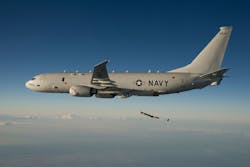Navy announces plans to integrate Lockheed Martin LRASM anti-ship missile aboard Boeing P-8A aircraft
PATUXENT RIVER NAS, Md. – U.S. Navy aerial warfare experts are surveying industry to determine the most qualified defense company to integrate the Lockheed Martin Long Range Anti-Ship Missile (LRASM) onto the Navy Boeing P-8A Poseidon maritime patrol aircraft.
Officials of the P-8A program office of Naval Air Systems Command at Patuxent River Naval Air Station, Md., issued a request for information (N00019-20-RFPREQ-PMA-290-0387) this week to determine if a contractor other than Boeing could integrate the LRASM onto the P-8A.
This type of request for information is common for jobs like this, but rarely do systems integration contracts go to companies other than the incumbent, which in this case is the Boeing Defense, Space & Security segment in Seattle. The P-8A aircraft is a militarized version of the Boeing 737-800ERX single-aisle passenger jet.
What's significant about this request for information is revealing the Navy's intention to fit the LRASM aboard the P-8A. Navy officials are asking interested companies about their abilities to perform aeromechanical and software integration necessary to install LRASM aboard the P-8A.
The Navy also is interested in fitting the Poseidon aircraft with 500-to-2,000-pound versions of the Joint Direct Attack Munition (JDAM); MK 62, 63, and 65 mines; Small Diameter Bomb (SDB-II); Miniature Air Launched Decoy (MALD); Bomb Rack Unit BRU-55; and Universal Armament Interface (UAI).
Companies must be able to upgrade the Boeing Tactical Open Mission Systems (TOMS) and Stores Management Computer (SMC) software and interfaces, as well as perform test planning, execution, data reduction, and reporting on flight tests. Companies must be able to support the Navy in designing, modifying, installing, and maintaining test aircraft and aircraft subsystems.
While Boeing is prime systems integrator of the P-8A, the aircraft's flight management system and the stores management system have been developed by GE Aviation Systems in Grand Rapids, Mich.
The plane's MX-20HD digital electro-optical and infrared (EO/IR) multi-spectral sensor turrets come from L-3 Communications Wescam in Burlington, Ontario. Its upgraded APS-137D(V)5 maritime surveillance radar and signals intelligence (SIGINT) system come from the Raytheon Co. Space and Airborne Systems (SAS) segment in McKinney, Texas.
The P-8A will have the CAE Inc. advanced integrated magnetic anomaly detection (MAD) system, and eventually may use air-deployable unmanned aerial vehicles (UAVs) to handle magnetic anomaly detection. The Navy plans to arm the P-8A with the MK 54 torpedo.
The LRASM, meanwhile, is a joint project of the U.S. Defense Advanced Projects Agency (DARPA) in Arlington, Va., the Navy, and the Air Force for launch from the Navy F/A-18E/F Super Hornet jet fighter bomber, as well as from the Air Force B-1B Lancer long-range strategic bomber.
In the future LRASM also will launch from the P-8A, F-35 Lighting II joint strike fighter, as well as from the Navy Mark 41 shipboard Vertical Launch System. Submarine-launched versions are under consideration.
LRASM is designed to detect and destroy high-priority targets within groups of ships from extended ranges in electronic warfare jamming environments. It is a precision-guided, anti-ship standoff missile based on the Lockheed Martin Joint Air-to-Surface Standoff Missile-Extended Range (JASSM-ER).
LRASM is to replace the ageing Harpoon anti-ship missile, and has a multi-mode radio frequency sensor, a new weapon data-link and altimeter, and an uprated power system.
The LRASM can be guided toward enemy ships from as far away as 200 nautical miles by its launch aircraft, can receive updates via its datalink, or can use onboard sensors to find its target. LRASM will fly towards its target at medium altitude then drop to low altitude for a sea skimming approach to counter shipboard anti-missile defenses. Lockheed Martin is in charge of LRASM overall development, and the BAE Systems Electronic Systems segment in Nashua, N.H., is developing the LRASM onboard sensor systems.
Companies interested in a chance to integrate LRASM aboard the P-8A aircraft should email capability statements no later than 18 Feb. 2020 to the Navy's Jessica Dean at [email protected] and to Ryan Delaney at [email protected]. Email questions or concerns to the same two people.
More information is online at https://beta.sam.gov/opp/e0453399274345038d1f3772d70e3392/view.
About the Author
John Keller
Editor-in-Chief
John Keller is the Editor-in-Chief, Military & Aerospace Electronics Magazine--provides extensive coverage and analysis of enabling electronics and optoelectronic technologies in military, space and commercial aviation applications. John has been a member of the Military & Aerospace Electronics staff since 1989 and chief editor since 1995.


